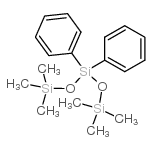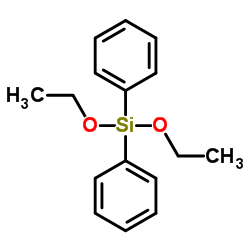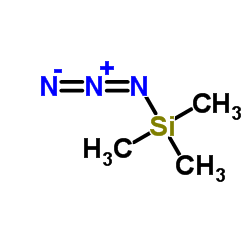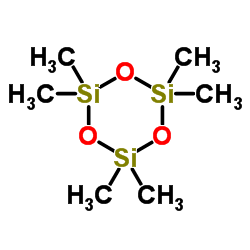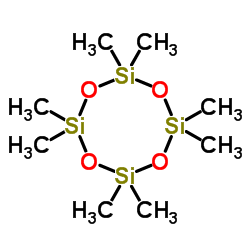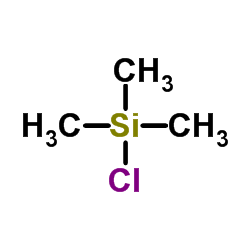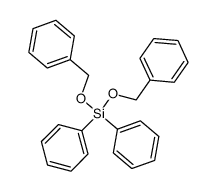797-77-3
| Name | diphenyl-bis(trimethylsilyloxy)silane |
|---|---|
| Synonyms |
2.2.6.6-tetramethyl-4.4-diphenyl-2.4.6-trisila-3.5-dioxaheptane
3,3-diphenyl-1,1,1,5,5,5-hexamethyl-trisiloxane 1,1,1,5,5,5-Hexamethyl-3,3-diphenyl-trisiloxan 3.3-Diphenyl-1.1.1.5.5.5-hexamethyl-trisiloxan trisiloxane,1,1,1,5,5,5-hexamethyl-3,3-diphenyl 3,3-DIPHENYLHEXAMETHYLTRISILOXANE HEXAMETHYL-3,3-DIPHENYLTRISILOXANE 1,1,1,5,5,5-hexamethyl-3,3-diphenyl-trisiloxane MFCD01320581 |
| Density | 0.98 |
|---|---|
| Boiling Point | 172ºC (18 mmHg) |
| Molecular Formula | C18H28O2Si3 |
| Molecular Weight | 360.67000 |
| Flash Point | 141.8ºC |
| Exact Mass | 360.14000 |
| PSA | 18.46000 |
| LogP | 3.94600 |
| Index of Refraction | 1.49-1.493 |
Synonym: Section 2 - COMPOSITION, INFORMATION ON INGREDIENTS
Risk Phrases: 36/37/38 Section 3 - HAZARDS IDENTIFICATION EMERGENCY OVERVIEW
Irritating to eyes, respiratory system and skin. Potential Health Effects Eye: Causes eye irritation. Skin: Causes skin irritation. May be harmful if absorbed through the skin. Ingestion: May cause irritation of the digestive tract. May be harmful if swallowed. Inhalation: Causes respiratory tract irritation. May be harmful if inhaled. Chronic: Not available. Section 4 - FIRST AID MEASURES Eyes: Flush eyes with plenty of water for at least 15 minutes, occasionally lifting the upper and lower eyelids. Get medical aid. Skin: Get medical aid. Flush skin with plenty of water for at least 15 minutes while removing contaminated clothing and shoes. Ingestion: If victim is conscious and alert, give 2-4 cupfuls of milk or water. Get medical aid. Wash mouth out with water. Inhalation: Remove from exposure and move to fresh air immediately. If not breathing, give artificial respiration. If breathing is difficult, give oxygen. Get medical aid. Notes to Physician: Section 5 - FIRE FIGHTING MEASURES General Information: As in any fire, wear a self-contained breathing apparatus in pressure-demand, MSHA/NIOSH (approved or equivalent), and full protective gear. Extinguishing Media: Use carbon dioxide or dry chemical. Section 6 - ACCIDENTAL RELEASE MEASURES General Information: Use proper personal protective equipment as indicated in Section 8. Spills/Leaks: Absorb spill with inert material (e.g. vermiculite, sand or earth), then place in suitable container. Section 7 - HANDLING and STORAGE Handling: Avoid breathing dust, vapor, mist, or gas. Avoid contact with skin and eyes. Use only in a chemical fume hood. Storage: Store in a cool, dry place. Store in a tightly closed container. Section 8 - EXPOSURE CONTROLS, PERSONAL PROTECTION Engineering Controls: Facilities storing or utilizing this material should be equipped with an eyewash facility and a safety shower. Use adequate ventilation to keep airborne concentrations low. Exposure Limits CAS# 797-77-3: Personal Protective Equipment Eyes: Not available. Skin: Wear appropriate protective gloves to prevent skin exposure. Clothing: Wear appropriate protective clothing to prevent skin exposure. Respirators: Follow the OSHA respirator regulations found in 29 CFR 1910.134 or European Standard EN 149. Use a NIOSH/MSHA or European Standard EN 149 approved respirator if exposure limits are exceeded or if irritation or other symptoms are experienced. Section 9 - PHYSICAL AND CHEMICAL PROPERTIES Physical State: Clear liquid Color: colorless Odor: slight odor pH: Not available. Vapor Pressure: Not available. Viscosity: Not available. Boiling Point: 172 deg C @ 18 mmHg Freezing/Melting Point: Not available. Autoignition Temperature: Not available. Flash Point: Not available. Explosion Limits, lower: Not available. Explosion Limits, upper: Not available. Decomposition Temperature: Solubility in water: Negligible. Specific Gravity/Density: 0.98 Molecular Formula: CH3Si(C6H5)2OSi(CH3)2OSi(CH3)3 Molecular Weight: 360.4513 Section 10 - STABILITY AND REACTIVITY Chemical Stability: Stable. Conditions to Avoid: Excess heat. Incompatibilities with Other Materials: Not available. Hazardous Decomposition Products: Carbon monoxide, carbon dioxide, silicon dioxide. Hazardous Polymerization: Has not been reported Section 11 - TOXICOLOGICAL INFORMATION RTECS#: CAS# 797-77-3 unlisted. LD50/LC50: Not available. Carcinogenicity: 3,3-Diphenylhexamethyltrisiloxane - Not listed by ACGIH, IARC, or NTP. Section 12 - ECOLOGICAL INFORMATION Section 13 - DISPOSAL CONSIDERATIONS Dispose of in a manner consistent with federal, state, and local regulations. Section 14 - TRANSPORT INFORMATION IATA No information available. IMO No information available. RID/ADR No information available. Section 15 - REGULATORY INFORMATION European/International Regulations European Labeling in Accordance with EC Directives Hazard Symbols: XI Risk Phrases: R 36/37/38 Irritating to eyes, respiratory system and skin. Safety Phrases: S 26 In case of contact with eyes, rinse immediately with plenty of water and seek medical advice. S 37/39 Wear suitable gloves and eye/face protection. WGK (Water Danger/Protection) CAS# 797-77-3: No information available. Canada None of the chemicals in this product are listed on the DSL/NDSL list. CAS# 797-77-3 is not listed on Canada's Ingredient Disclosure List. US FEDERAL TSCA CAS# 797-77-3 is not listed on the TSCA inventory. It is for research and development use only. SECTION 16 - ADDITIONAL INFORMATION N/A |
